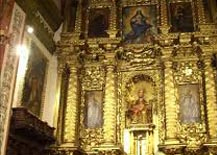
Locality: OLITE (31390)
Address: Calle El Fosal, 2
Zone: The Central Zone
Style: Romanesque
Centuries of construction: XII
Visiting hours: los oficios tienen lugar de lunes a sábado, a las 10:00; domingos y festivos, a las 10:00 y a las 12:30.
Tel.: 948740056
Description
A slender Gothic tower, crowned by a graceful arrow, known as the “Torre de Aguja” (needle spire), identifies the church of San Pedro Apóstol of Olite, which stands next to the Royal Palace in the town. This lovely church, whose construction began in the 12th century, harmoniously blends Romanesque,
Gothic and Baroque styles. It is the oldest church in the town and, amongst other artistic treasures, preserves a Romanesque cloister from the middle of the 13th century, a Gothic sculpture of St. James, an interesting high altarpiece and, in a Gothic tomb, a polychrome alabaster relief that represents the Trinity.
The church of San Pedro presides over the main square of Olite, a town in the Central Zone of Navarre that boasts one of the most outstanding monumental complexes in the region. The church, which was started during the Romanesque period and extended in the Baroque period, is the oldest in the town. Its most notable features are its façade, cloister and slender Gothic tower.
Façade
Its Romanesque façade is elegant and austere; a semi-circular splayed arch with six smooth archivolts between richly decorated friezes with a chequered design and plant motifs. Notable features are the capitals showing the fight between St. George and the dragon and that of a centaur against a harpy.
The tympanum and lintel are Gothic additions; in the tympanum St. Peter, St. Andrew and St. James are represented, and the lintel relates scenes from the life of St. Peter. The façade is rounded off with a frieze decorated with a mass of leaves and mythological scenes, and a beautiful rosette.
Gothic tower
One’s eye is drawn to the original Gothic tower, 52 metres high, which serves as a platform for the 14th-century octagonal spire. It is an interesting example of its genre due to its architectural strength and the gracious curvature of its ribs. The bell-tower was decorated with Gothic mural paintings from the 13th century, but to see them you will need to go to the Museum of Navarre in Pamplona, where they were put for reasons of conservation and safekeeping.
Cloister
Adjacent to the building, on its northern side, is a galleried cloister from the middle of the 13th century, in a square layout. It is formed by semicircular arches supported by walled columns. On its capitals you can clearly distinguish the shapes of plants, human faces and scenes from Genesis featuring Adam and Eve.
The inside of the church is rectangular in shape. The central nave and the two lateral naves are covered by ribbed vaults and the cross by a hemispherical dome on pendentives. The grandiose Gothic cruciform pillars contribute to increasing the monumental sensation of the church.
The high altar is a Baroque work dedicated to St. Peter. It is accompanied by canvas paintings of the patron saints of Navarre, St. Fermín and St. Francis Xavier, painted by Vicente Berdusán. The chapel of the Virgin de la Campanal is a proto-Gothic construction which was decorated with murals painted at the end of the 13th century. They are not on display in the Museum of Navarre (in Pamplona) and are regarded as some of the most important Navarrese mural paintings of the era.
The church also houses the tomb of the Notary of Olite, Enequo Pinel, who ordered it to be built in 1432. Its main peculiarity is the representation of the Trinity with three people. It was made by Jean Lome de Tournay, the favourite sculptor of King Carlos III ?the Noble’, and the most important sculptor in Navarre in the 15th century. One of his masterpieces is the tomb of Carlos III and his wife Leonor, in Pamplona cathedral.







